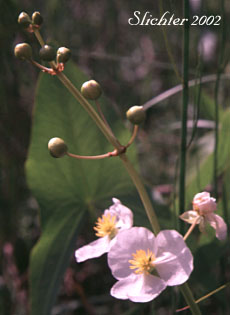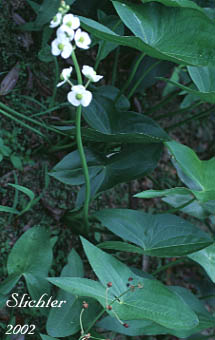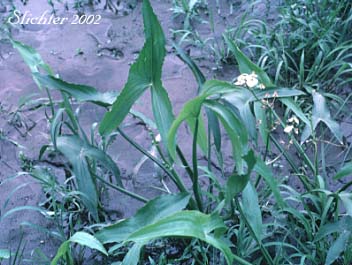

 The
photo at right shows broadleaf arrowhead as seen at Sauvies Island, west of Portland,
Oregon...........August 1994.
The
photo at right shows broadleaf arrowhead as seen at Sauvies Island, west of Portland,
Oregon...........August 1994.
The prefix of the genus name, sagitta- means arrow.
Broadleaf arrowhead is sometimes known as wapato, or occasionally as floating arrowhead. It is an attractive aquatic plant, especially the arrowhead-shaped leaves. Plants are perennial and are up to 90 cm high, with several to many very long petiolate leaves arising from a fleshy rootstock or tuber. The leaf blades are mostly arrowhead-shaped and are up to 25 cm long and nearly as wide. The basal lobes spread widely. The petioles are up to 60 cm long. Submerged leaves may be completely bladeless.
The flower scapes are 20-50 cm long and topped by 2-8 whorls of flowers. The bracts of the inflorescence are blunt or rounded and 5-10 mm long. The flowers consist of 3 orbicular, white petals which measure 10-20 mm long. The stamens usually number more than 20. Plants either have one sex of flower per plant or flowers of both sexes on a plant.
Plants bloom from July to September in the Pacific Northwest.
The tubers of the arrowheads are edible when roasted or boiled. They were important food sources of first the Native Americans and then the pioneers. Wapato is often used as a decorative plant for small ponds and lakes.
Once common in the Pacific Northwest, its numbers soon dwindled due to the introduction of the European carp which eats the tubers.
Broadleaf arrowhead may be found both in water and along the muddy shores of rivers and ponds.
Broadleaf arrowhead may be found mostly to the west of the Cascade and Sierra Nevada Mts. from Vancouver Island south to central California. It is also reported from southeastern Washington and northern Idaho. It may also be found from Arizona south through central America to northern South America. It may also be found in the West Indies and Hawaii.
